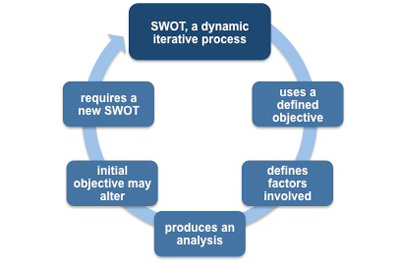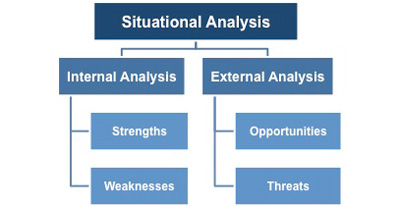Strengths, Weaknesses, Opportunities, and Threats

Before looking at how the SWOT analysis can be applied to your organization, it is important to be clear about what exactly we mean by the terms Strengths, Weaknesses, Opportunities, and Threats.
Strengths - Internal factors that are favorable for achieving your organization's objective.
Weaknesses - Internal factors that are unfavorable for achieving your organization's objective.
Opportunities - External factors that are favorable for achieving your organization's objective.
Threats - External factors that are unfavorable for achieving your organization's objective.
These definitions are open to interpretation and a weakness of the SWOT technique is that it can be highly subjective. For example, if your organization was dependent on one single large distributor then this could be seen as a strength, as you would be able to get your products into the market quickly and efficiently. However, it could also be seen as a weakness because you are totally dependent on them to do so.
Some factors will always be easy to categorize. For example, it is difficult to imagine huge financial resources, a broad product line, no debt, and committed employees being anything other than strengths, whatever the objective of the organization may be.
However, some factors can be either strengths or weaknesses depending upon the business objective. For example, a large number of distributors could be a strength if your objective is to place your products in as many outlets as possible. But if could be a weakness if your objective was to control your retail prices and prevent discounting.
The strength of the SWOT analysis comes from the fact that it can be applied to many different organizational scenarios, but its weakness is that it requires clear thinking and good judgment to obtain any real value from using it. You will often see SWOT analysis for an organization in which no specific business objective has been stated (see the example SWOT for Audi). These top-level SWOTs can have value in guiding strategy at the very highest level, but when a potential strategy has been identified and is being considered as a business objective then additional SWOTs will be required at this lower level.
Remember, when you are using the SWOT analysis technique, the processes of clearly identifying the business objective and categorizing the SWOT factors are equally important because they are interdependent.
This interdependence means that the SWOT analysis is often an iterative process in which the findings cause the objective to be reset and another analysis made. The output of any particular analysis is not necessarily definitive.
 |
The analysis is normally performed at a meeting involving representatives from the necessary stakeholders groups that have specialist knowledge and supporting data. Each of these individuals brings their own particular perspectives and expertise to the discussion.
The end result of such a meeting or series of meetings is a completed SWOT report. The success of this type of meeting relies on a strong and effective Chair who is familiar with the SWOT process and can successfully manage discussions, drawing out key points to gain consensus.
The Chair needs to take an active role in encouraging attendees to contribute to such discussions and brainstorm through the SWOTs in order to identify as many factors as possible. This is important when opportunities and threats are being considered, as these are often things that people within the organization have certain preconceptions about, or may be actively hostile to admitting the existence of.
For example,
The rapid uptake by music lovers of the MP3 format seemed to take many established record companies by surprise. Whilst the record companies must have been aware of the existence of this new format, it is not difficult to imagine a scenario where people in strategy meetings would be reluctant to point out just how much of a threat (or opportunity) this new way of consuming music could be.
As the implications would have threatened the established organizational structure, as well as rendering obsolete a business model that had remained unchanged for over 50 years, it must have been a difficult subject to discuss objectively!
The difficulty of admitting the existence of internal weaknesses in the organization is even more problematic and in some organizations it is impossible to talk about weaknesses objectively because senior management are in a state of denial about them. This can completely emasculate the SWOT analysis process, a problem that is discussed later.
It is extremely important that those involved in such strategy meetings are encouraged by the Chair to think of and generate ideas for deliberation, no matter how far-fetched they may appear. By suspending criticism and judgment till the final stages of the process, participants will feel free to generate unusual ideas that could prove to be valuable.
 |
One of the most effective ways to achieve this is to focus on internal factors to begin with and then on external factors later. Once all of these have been cataloged, then discussions on each point's relevance and likelihood can take place.
You may also be interested in: Definition of SWOT Analysis, Strengths, Weaknesses, Opportunities, and Threats, Internal Factors (Strengths and Weaknesses), External Factors (Opportunities and Threats), Matching and Converting, Advantages and Disadvantages and SWOT Analysis Example.



